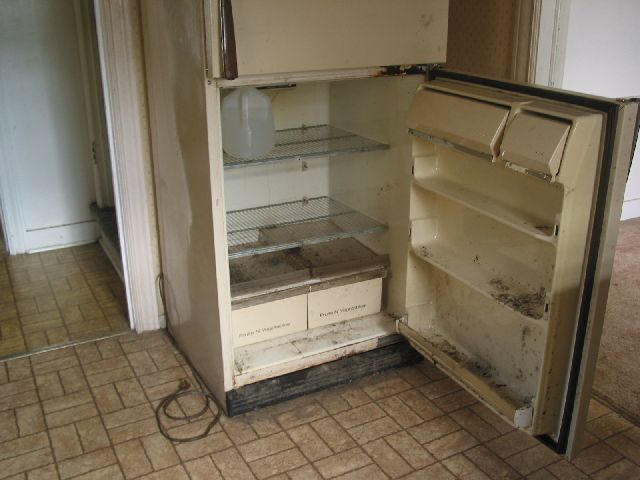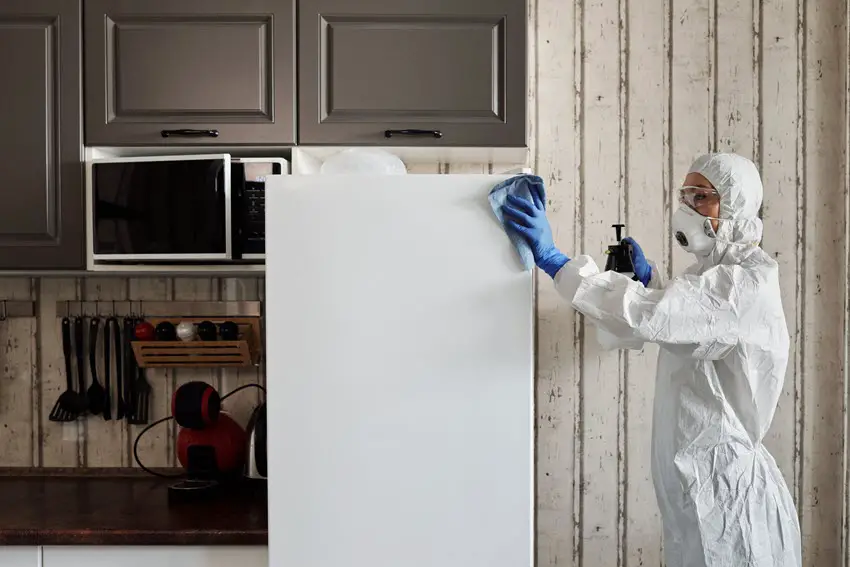There is nothing worse than going to your fridge to see what is for a snack, only to be met by a smell that can only be described as forceful when you open the door.
The most significant cause of these odorous horrors is the development of mold within the fridge.
Humans can be severely adversely affected by mold spores, so we have a highly tuned olfactory system to detect their scent. Unfortunately, the fridge can quickly become the perfect environment for mold if they are not kept well maintained and sanitized.
If you have discovered you have a mold colony in your fridge, do not panic. There is a straightforward process you can follow to get rid of the mold permanently all on your own.
Which Cleaning Products and Techniques Are Effective At Permanently Removing Mold?

There are multiple different cleaning products you can pick up at the store, which will tout benefits for killing molds or mildew use. You do not need any specialized products to get rid of mold in the fridge. You probably have everything you need at home already.
Vinegar

Vinegar is not just great to add a little bit of acidity to your meals; it can also serve as a powerful disinfectant for cleaning purposes. The high acidity level is toxic to nearly all forms of mold and mildew you are likely to encounter in the fridge.
Fill up a spray bottle with some white distilled vinegar for a quick and easy disinfectant spray you can use to get rid of fungal growth and other microorganisms.
Low Humidity and Good Airflow
Molds and mildew use require particular conditions to thrive and reproduce successfully.
Unfortunately, the interior of a fridge is almost the ideal environment for most species of mold. They do the best when it is relatively cold but not frigid and that there is a decent amount of moisture in the air.
Well ventilated spaces are less than ideal for mold and can deter their growth.
Adding a desiccant to your fridge to absorb any excess moisture in the air can do wonders to prevent future mold outbreaks by making the fridge and inhospitable environment for the mold. Regularly clean the refrigerator and keep things spaced out so airflow can reach all areas of the interior.
Baking Soda
If you go through the cleaning process and use vinegar when you are done, there could still be some residual smell inside your fridge. This can be infuriating, especially if you are uncertain whether there remains a living source for the smell or if it merely is lingering in the air.
Baking soda is an incredibly powerful deodorizer on top of its vast utility as a staple cooking item.
You can use a baking soda paste with one part water for every four parts baking soda to create a scrub that you can use to apply abrasive force to any messes in your fridge while deodorizing everything.
A Special Note About Using Bleach To Clean Your Fridge:
In the past, the cleaning product of choice around the house sold for fungal growth and molds was bleach.
The issue with using bleach to clean the interior or exterior of your fridge is that it is a corrosive material. It will eat through the material of your refrigerator and cause it to break down over time.
In a pinch, it can be useful if you need it and are unable to find any alternatives, but you should not use it regularly if you want to keep your fridge in good shape for very long.
Step-By-Step Guide for Cleaning Your Fridge of Mold

Now we can look at the step-by-step process to remove molds from your fridge permanently.
- Gather All Of Your Supplies:
Make sure that in addition to the cleaning products listed above, you also have the following materials: washcloth, paper towel, bucket for water, and a trash bag for trash. - Empty The Fridge Out Entirely:
When you open the fridge, go through everything in it, and throw away anything expired. Everything else can be set aside. - Break Down All Components Of The Fridge:
Most modern fridges will have drawers that are removable for produce, fruits, or dairy products. Break everything down into the smallest piece as possible. - Begin By Applying Your Vinegar Cleaning Solution To The Fridge Is Accessory Components:
Using the whole white wine distilled vinegar, you put in the spray bottle a little earlier to spray down all of the fridge components that were just removed in the previous step. - Wipe Down The Accessory Components With A Clean Paper Towel:
Allow the vinegar to sit on the surface for a few minutes to work its disinfecting magic. Then go over with a clean paper towel and wipe everything down until it is dry. - Apply The Cleaning Solution To The Fridge’s Interior, And Then It’s Exterior:
Using the same method you did for the fridge’s components, spray down the refrigerator’s interior and exterior with the white wine vinegar solution. - Wipe Down The Interior And Then The Exterior Of The Fridge With A Paper Towel:
After the white wine vinegar has finished working its magic wipe everything down with a paper towel inside and outside the fridge. - Go Over Everything Once Again With A Baking Soda Water Paste Scrub:
If there is still a smell in the fridge, get some baking soda and mix it with water until you have a paste, then take this paste and, with a washcloth, scrub down every piece of the fridge thoroughly. - Wipe Everything Off With A Wet Towel:
The baking soda paste should leave a then grainy residue over most of the fridge. Clean all of this up with a wet paper towel and throw the paper towel away. - Dry All Of The Items And Put The Fridge Back Together:
Dry off the interior of the fridge and begin drying items off and placing them back inside. - Replace All Of The Items Inside Of The Fridge and Add an Open Box Of Baking Soda:
Once everything is back inside the fridge, you can open up your box of baking soda and leave it in the side door pocket. This will help to absorb any remaining or future odors and keep things smelling like they are brand-new.
Here is a video walkthrough on how to clean a moldy refrigerator: